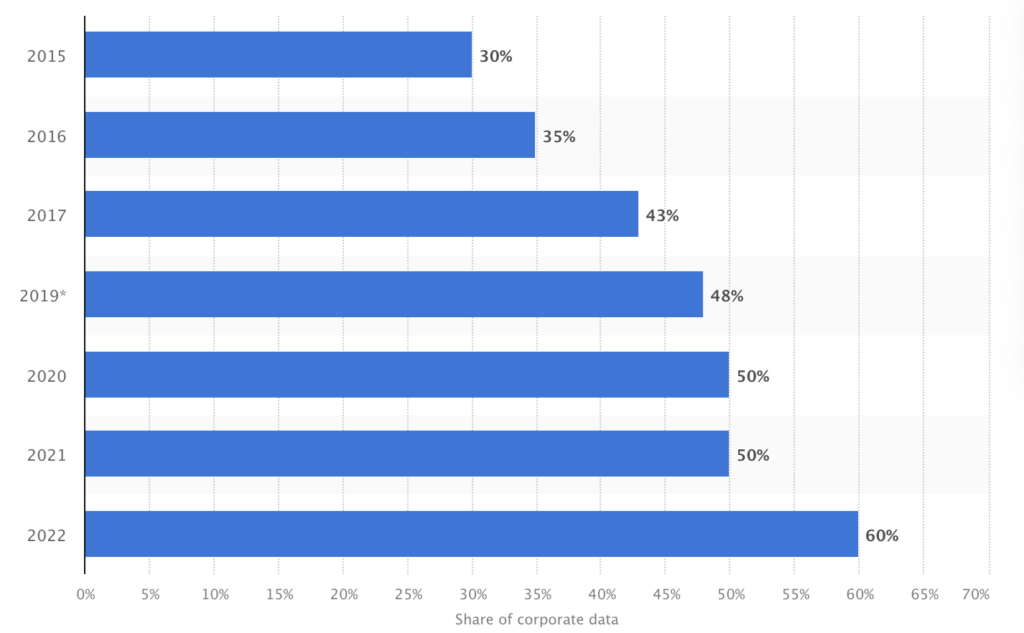We all look up and see clouds daily, but lately, the term “the cloud” has become even more common than what we see in the sky. But how did the cloud gain the popularity it has today? This blog will dive into the history of cloud-based solutions–from their early beginnings to today’s cutting-edge technology and widespread adoption. We’ll explore how computers have evolved and how the internet’s invention revolutionized our ability to access data from anywhere. Finally, we’ll discuss how cloud storage transformed into a crucial element in today’s digital age and where we can expect it to go.
Before the Cloud
In the mid-60s, sharing computer time over telephone networks became popular in large companies and government agencies. Allowing one central computing system to be shared by many users sitting at their monitors within the same building (TechTarget, 2022). The popularity of personal desktops, or minicomputers, paved the way for data centers and cloud computing servers.
The Cloud’s Beginning
The cloud gained popularity in 2006 when Amazon introduced Elastic Compute Cloud. This allowed users to run their applications online through Amazon Web Services (Dataversity, 2021). Businesses had too much software and data to be stored somewhere, and computers couldn’t keep up. Its purpose was to address service and security issues due to slow computer speeds. The cloud allows the storing and sharing of data and resources on an online platform. More companies adopted cloud-based solutions, resulting in productivity and performance improvements with platforms users can rely on 24/7.
The Cloud Today
With the explosion of the internet in 2010 came a new era of communication. From cloud storage to internet-based calls, users found themselves being able to connect anywhere, anytime. Since 2010, companies have increasingly stored more data in the cloud. Last year, Statistica sites that 60% of all corporate data is stored in the cloud. And with cloud-based solutions like Unified Communications (UC), companies can now access all their communication features on one mobile platform. The digital revolution couldn’t have come at a better time!
Share of corporate data stored in the cloud in organizations worldwide from 2015 to 2022

from 2015 to 2022
When COVID-19 accelerated the demand for cloud-based solutions in 2020, it was all hands on deck. As employees were told to work from home, businesses quickly realized effective virtual communication was no easy feat. SaaS tools, like UCaaS, were able to meet the demand for virtual communication and accommodate the new surplus of remote employees. Using SaaS, coworkers could communicate through cloud messaging, video calls, and screen-sharing.
Future of the Cloud
Despite the world’s uncertainty during the pandemic, one thing was for sure, remote-friendly work was here to stay. As the dust settled, hybrid work models started to gain more attention post-pandemic. Companies are capitalizing on the benefits of cloud-based solutions, such as organizational and communication features for remote work, while keeping an in-person work environment and culture. In 2022, Gartner stated that 31% of all workers worldwide would be working either fully or partially remotely. What started as waiting in line for your turn to have computer time became opening up your laptop to universally available multi-cloud space. The cloud helped pave the way for communication services within SaaS, offering businesses a way to work over the internet. Providing relief in a time of chaos with a reliable way for businesses to communicate from anywhere and keep up with the changing work environment. Given that the cloud was able to be exceptionally successful throughout such a challenging time as the pandemic, it is reasonable to predict that the cloud has a bright future ahead of itself, no pun intended.
Written by Level365 Intern, Lexie Henry





